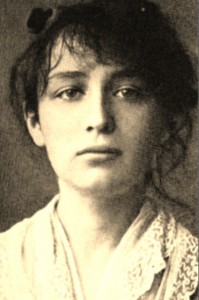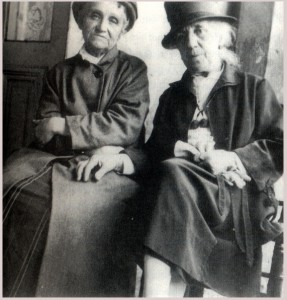Camille Claudel: Into the Fire, San Francisco Performances
DiDONATO PROVED AN IDEAL INTERPRETER
“As he has done for singers throughout his career, Heggie has made the cycle a glowing showcase for the vocalist. The writing for quartet — filled with insinuating themes and deft harmonies — sets the stage, but never intrudes. And the vocal parts are brilliant: spare and pristine in several settings, luxuriantly ornamented in others. This is a work that sings, ardently, melodically, and dramatically. (Cont…)
DiDonato proved an ideal interpreter. With the first song, “Rodin,” the mezzo established Camille’s voice with pure tone and crisp articulation, summoning a haunting sense of anguish and rendering the printed texts superfluous. “La Valse,” sung over the strings’ fleet, agitated lines, brought a soulful cry for consolation. DiDonato’s finest moments came in “Shakuntala,” a great aria of regret and remembrance; here, the mezzo’s voice rose in urgent flights as Camille grasps for fragments of her identity.
In the remaining songs, Heggie and Scheer focus on the pathos of Camille’s retreat into madness. In “La petite Chatelaine” she sings to her lost child, describing herself as a mother to “children of stone”; DiDonato advanced the text softly over a delicately etched melody. In “The Gossips,” DiDonato floated exquisite tone on the “whispers” of the quartet’s fleet, incisive lines. The subsequent instrumental interlude, “L’Âge mûr,” deploys a dark, drifting music, perhaps to illustrate Camille’s final break with Rodin. The cycle ends with an Epilogue, called “Jessie Lipscomb visits Camille Claudel, Montdevergues Asylum, 1929.” Here, Camille reclaims a measure of her youthful poise and sweetness, and DiDonato’s performance was suffused with deep feeling.
Heggie and DiDonato opened the program’s first half with a beguiling performance of Reynaldo Hahn’s Venezia. Many artists have assayed these quintessential French songs composed in homage to Venice; baritone Christopher Maltman sang them beautifully on this very stage just last month. Still, I don’t think I’ve ever heard them sung with such allure as DiDonato did on Saturday. With Heggie supplying subtle accompaniment, her pristine diction and honeyed tone made them sound newly minted.
All the evening’s performers returned for the single encore, a radiant traversal of Richard Strauss’ Morgen!”
~ Georgia Rowe Classical Voice February 2012
The dramatic song cycle that composer Jake Heggie and librettist Gene Scheer have fashioned from her life is also a heartbreaker – a score of deep, squishy sentimentality and enormous beauty. The two qualities are intertwined in the piece; you can’t have one without the other.
“Camille Claudel: Into the Fire had its world premiere Saturday night in Herbst Theater, in a concert presented by San Francisco Performances, which commissioned the work. The occasion was the 30th anniversary of the estimable Alexander String Quartet, which accompanied mezzo-soprano Joyce DiDonato in a ravishing performance.
To admire the work means accepting its basic premise, in particular its determination to view Claudel as the victim of forces around her. Admittedly, this is not hard to do. Her relationship with Rodin, which was both artistic and erotic, caused her as much grief as any such romance between mentor and protegee, and came to an end after she aborted their child. As her work grew more personal, her behavior grew more erratic and paranoid. In her late 30s, she was committed by her family to an asylum, where she lived out the remaining 30 years of her life in near-total isolation.
All but one of the seven movements of “Camille Claudel: Into the Fire” (six songs and an instrumental fugue) are based on one of her sculptures, and the relationships are both clear and telling. The swirling kinetic force of “La Valse” (which Debussy kept on his mantel) finds a reflection in the dance rhythms that run through nearly all of Heggie’s score. “La Petite Châtelaine,” a bathetic bust of a little cherub, elicits an address to Claudel’s lost infant.
Most touching, though, is the epilogue, based on a visit to the asylum by Claudel’s art-school chum, the English sculptor Jessie Lipscomb. The
photo of the two old ladies sitting side by side says volumes, and Heggie and Scheer sagely allow a few words and nearly spoken phrases to convey the emotion of the moment.
Heggie’s score is cast almost entirely in a mournful minor key, with a handful of recognizable melodic motifs set to waltz rhythms. The effect is weepy but arresting; it manipulates the listener’s emotions so skillfully you almost don’t mind.
Not even DiDonato was immune – as she sang the work’s last line on Saturday, she teared up, and had to turn away to recover before taking a bow. The ovation was tumultuous and well deserved, not only for the piece but also for the luminous and fiercely lovely performance.
The first half of the concert was equally affecting. It began with Heggie accompanying DiDonato in a superb account of Reynaldo Hahn’s song cycle “Venezia,” a witty and insinuating collection of bonbons, and continued with a strong-boned but tender rendition of Debussy’s String Quartet in G Minor. As an encore, all six performers joined forces for Richard Strauss’ “Morgen!” delivered with rapturous serenity.”
~ Joshua Kosman San Francisco Chronicle February 2012

